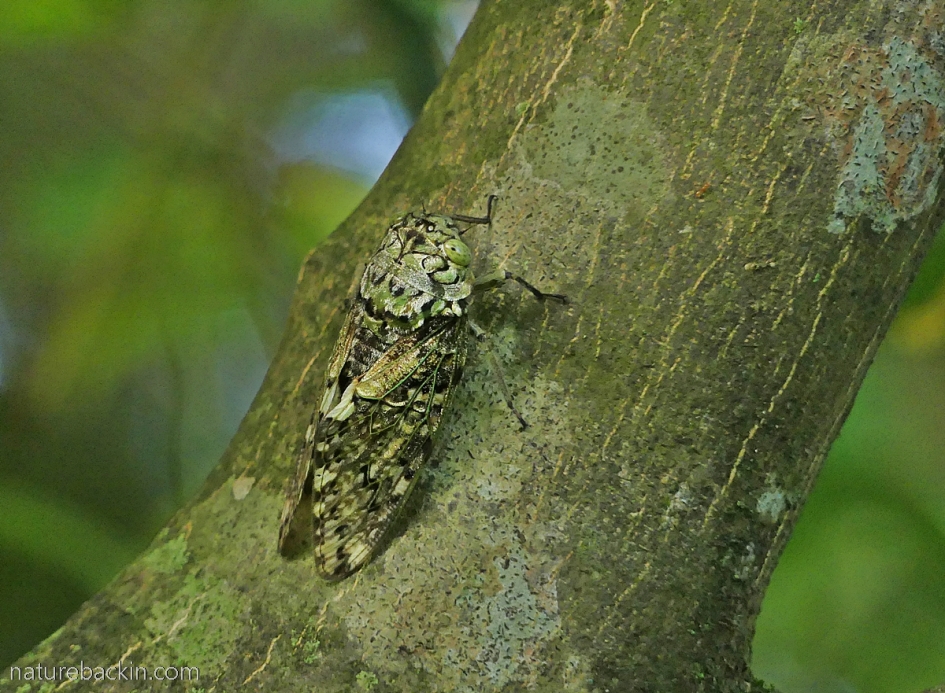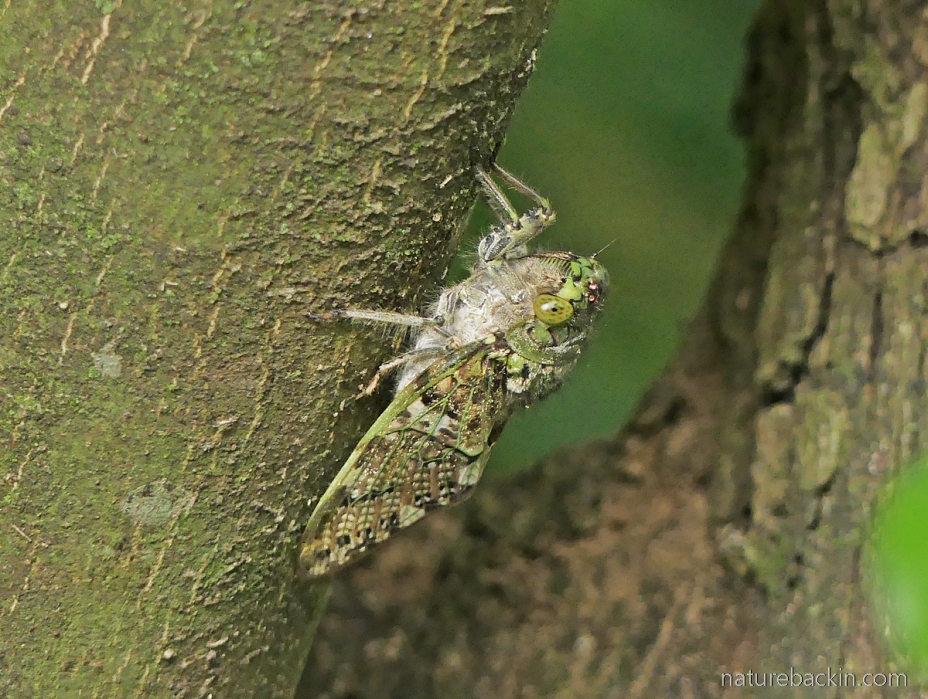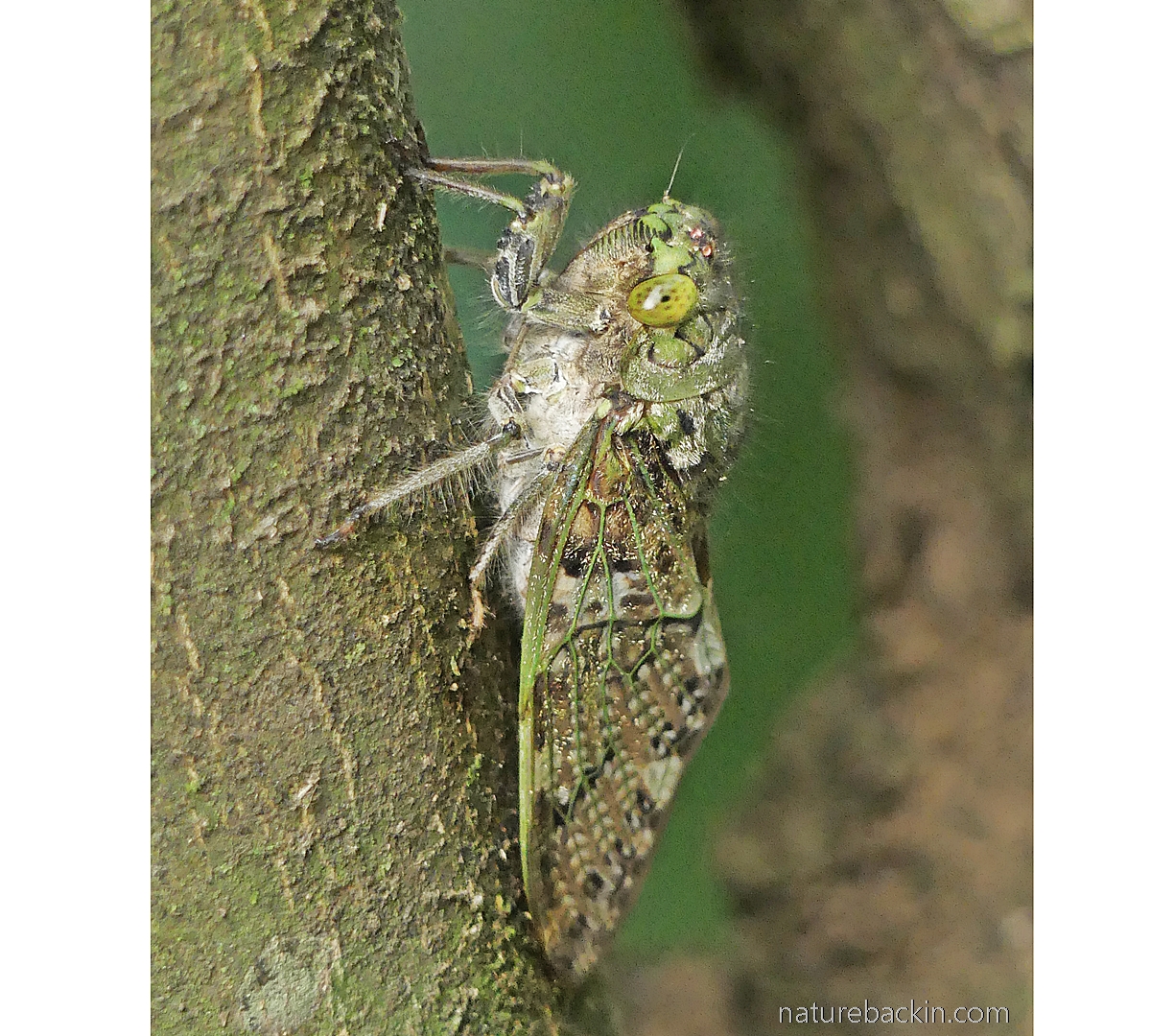So loud and so tantalizingly near, cicadas tend to fall silent when approached, and their camouflage colours make them hard to see. But recently I was in luck as after hearing a faint cicada-like squeak from a tree, I stood still and scanned the stems of the tree methodically and then suddenly several cicadas became surprisingly obvious.
It was late on an overcast afternoon when walking in our garden and passing the horsewood/perdepis tree (Clausena anisate) that I heard a brief squeaking from a cicada somewhere in the tree at about head height. It took quite some time in the dim light for my eyes to distinguish first one cicada and then after a minute or two I counted a total of nine cicadas, all perfectly still and silent relying on their cryptic colouration to conceal them.

In the low light their mottled appearance seemed to mimic lichen on the branches of a tree. As it was too dark that afternoon for successful photography, the next morning I went out when it was light enough to see if the cicadas were still there – and they were. These photos were taken the next morning when the light was a bit better, ahead of gathering clouds on another rainy day.
These cicadas are quite large – about 5 cm (2 inches) in length. According to Jason Londt in his book Suburban Wildlife in KZN, the commonest suburban cicada is the giant forest cicada (Pycna semiclara), but I cannot be certain of the ID of the cicadas I photographed. There are about 140 cicada species in South Africa, with about 38 species known to be in KwaZulu-Natal, with 16 of these species being endemic, many limited to quite specific areas (Armstrong & Villet, 2019).
Looking at several photographs online and in books of the giant forest cicada, they appear greener in colouration than the ones I saw, and their eyes are brown rather than green.

Perhaps these green-eyed cicadas are giant forest cicadas, perhaps not, but in common with all cicadas, it is the males that call. They do not stridulate (like crickets for example) but have two tymbals (round sound-producing organs on either side of the abdomen). These tymbals appear to be two round membranes each reinforced by a strong ring. Using muscles to contract this membrane and allow it to recoil is how the cicada produces its sound. The sound is amplified by an air chamber below the membrane and multiple layers over the membrane can be manipulated to modify the pitch of the call.
The call serves to attract potential mates and the giant forest cicada also has a more trilling territorial call. For giant forest cicadas (and the species in our garden) once one male starts his very high, loud and continuous call other males join in a chorus that is so piercing it is difficult to locate with any precision where the sounds are coming from.

For a brief moment one of the cicadas started calling while I was watching. I was not sure which one was calling, but then I noticed a visible vibration on one of them, at the point where the wings start to meet in the middle of the back – about where the two black dots/stripes are visible where the wings almost meet as seen in the photo above.
The life-cycle of cicadas is most interesting and in their larval stages, which take place underground, some species of cicadas live for many years. For more about these interesting bugs see my post that was inspired by the terracotta exoskeletons of cicadas that I found in the garden.

The little red dots that resemble jewel-like droplets visible on the ‘forehead’ of the cicada are in fact ocelli, three primitive eyes that are sensitive to light and are used in conjunction with the large compound eyes.
In conclusion, perhaps I should explain that this week several neighbouring suburbs, including ours, had no electricity for four days (due to damaged underground power cables). This longish outage stretched the capability of our small home backup system as well as affecting the reliability of connectivity to the Internet. It was a huge relief when power was restored last evening.
Consequently, I was delayed in preparing and publishing this post. Also, I am even more behind than usual in my reading of the many blogs that I enjoy – so I apologise for that and hope to do some catching up in the week ahead.
Sources:
Armstrong, Adrian John; & Martin H Villet. 2019. Checklist, endemism, English vernacular names and identification of the cicadas (Insecta, Hemiptera, Cicadidae) of KwaZulu-Natal, South Africa. African Invertebrates 60(2): 165-193. https://africaninvertebrates.pensoft.net/article/35130/; Londt, Jason. 2009. Suburban Wildlife in KZN. A Wildlife Handbook, WESSA KZN; Picker, Mike; Charles Griffiths & Alan Weaving. 2019. Field Guide to Insects of South Africa. Cape Town: Struik Nature.
Posted by Carol









February 23, 2021 at 1:12 pm
These creatures are so much part of my memories of Christmas and your post gave so much interesting information as well as the excellent photos. I don’t recall hearing any here in Onrus.
LikeLiked by 1 person
February 27, 2021 at 1:47 pm
Thanks Christine – the association of cicadas and Christmas is just so strong. It will be interesting to find out about cicadas in the Western Cape.
LikeLike
February 13, 2021 at 7:10 pm
PS Glad your power was restored! 🌟
LikeLiked by 1 person
February 13, 2021 at 7:51 pm
Thanks – it was a relief. We still have scheduled rolling blackouts across the country quite regularly, but each planned outage is only 2 hours. Not only is that not long but being scheduled it is possible to plan around it – if I remember in time. Important when baking bread!
LikeLiked by 1 person
February 13, 2021 at 7:09 pm
Hi Carol, Your images of cicadas are so beautiful. The textures and colors are amazing. Reminds me of growing up and having a deluge of cicadas every 7 or was it 17 years… but they were everywhere! My memory is that they were much darker but honestly I never got that close to them. 🙂
LikeLiked by 1 person
February 13, 2021 at 7:48 pm
That is interesting that long cycle between each deluge of cicadas. I wonder if that is related to the length of time the larvae are underground before emerging as adults? I have read that for some species that can be many years.
Getting close to these cicadas and having enough light was extremely fortunate and I was amazed to see how lovely they are.
LikeLiked by 1 person
February 14, 2021 at 5:08 am
Yes, I think the larvae are dormant and emerge every 17 years. Dinging into memory banks which are quite faulty these days…😀
LikeLiked by 1 person
February 14, 2021 at 6:00 am
That cicada life cycle is incredible and no wonder it still resides in the memory bank 😊
LikeLiked by 1 person
February 12, 2021 at 8:49 pm
Beautiful, cryptic, atmosphere-inspiring. What would the tropics be without their voice?
Glad you got your power back. Four days is too long to go without a reliable supply unless one is camping in the wilderness and thus expecting and prepared for it.
LikeLiked by 1 person
February 13, 2021 at 6:59 pm
Yes the sound of cicadas is such an intrinsic sound of summer.
We do bring some of our camping gear into use during such power outages. Fortunately we have a gas cooker. When camping we use the sun to heat water (a reflective box and black kettle) but the power outage coincided with continuously cloudy and rainy days, so no sunshine for that.
We have a small inverter and battery to run our modem and a few lights etc but that only lasts about a day. As time without power goes on though the fridge becomes a problem.
LikeLiked by 1 person
February 9, 2021 at 6:56 am
Cicadas singing, such a wonderful description, always evoke summer! Thank you Carol! xxx
LikeLiked by 1 person
February 9, 2021 at 3:07 pm
Yes – one of the essential sounds of summer. I can hear them calling as I write this.
LikeLiked by 1 person
February 7, 2021 at 10:11 pm
From your description, I can almost hear the cicadas in my mind’s ear (is that even a thing?!). Your post inspired me to look up videos of them calling, buzzing, and singing. How lucky—and skillful—you were to see them and get such lovely photos. But how unfortunate to suffer such a long power outage. Hope all is restored and no goodies went to waste.
LikeLiked by 1 person
February 8, 2021 at 3:25 pm
Thanks Cheryl. There was a lot of luck in seeing those cicadas. They are such interesting little beasties.
Yes our power was restored and its been okay since then thanks, and we managed with the fridge – we always keep bottles of water frozen and transfer one or two from freezer to the fridge to help keep it cool. And our battery managed enough power to boost it briefly, which was just enough …
LikeLiked by 1 person
February 8, 2021 at 9:14 pm
You are better prepared than I. Power goes out here and I rely on my collection of blue ice blocks!
LikeLiked by 1 person
February 8, 2021 at 9:25 pm
Oh yes we have those too!
LikeLiked by 1 person
February 6, 2021 at 10:54 am
Thank you……… I heard them but never really identified them when we lived next door to you. Now I will follow your instructions. Follow army method =- stay still and look for breathing motion..
LikeLiked by 1 person
February 8, 2021 at 3:19 pm
Ooh I was not that methodical in my scanning response when looking for cicadas, but your description made me laugh.
I have tried said method several times since – but no luck. The cicadas fall silent and remain well hid.
LikeLike
February 6, 2021 at 10:46 am
When I saw your photographs of the cicadas on your perdepis tree I thought that when identified a (dead) cicada in our Hogsback garden a while ago I had been mistaken. Then I read that green is a more usual colour and felt vindicated. The ones that live at Hogsback are an iridescent emerald green and they make a deafening, continuous, piercing sound on a hot summer’s day.
Glad to know your power is back (apart from the load shedding hours over the weekend) and that it was not something more serious that kept you from posting your Thursday blog.
LikeLiked by 1 person
February 8, 2021 at 3:15 pm
I gather that giant forest cicadas occur in the Hogsback region too – but with so many species and very local endemics they are hard to identify.
Thanks for your concern re my delayed posting. We were spared the Friday and Saturday load shedding. Perhaps we had already paid our dues! 🙂 I was still glad to see it was suspended on Sunday.
LikeLiked by 1 person
February 6, 2021 at 10:30 am
140 types of cycads, that’s quite a lot! I am happy about your terrific pictures. It’s rare to find something like this on blogs.
LikeLike
February 8, 2021 at 3:10 pm
Thanks very much Simone 🙂
LikeLiked by 1 person
February 6, 2021 at 10:25 am
What an interesting read on the Cicadas! I read both articles you did on Cicadas. You certainly have some amazing photos showing their incredible camouflage. I have only seen the dry exoskeletons unfortunately, but I’m now interested in trying to see the adult when they call. Their lifecycle is incredible and I had no idea that there were that many species of cicadas in the world.
LikeLiked by 1 person
February 8, 2021 at 3:09 pm
Thanks very much. I have seen the dry exoskeletons much more often than live adults. SInce I took those photos I have continued looking for cicadas in the garden but have not seen any again even though they are still calling. I was also surprised to learn how many species there are and the longevity of some species is incredible.
LikeLiked by 1 person
February 14, 2021 at 11:17 pm
I still have not seen a live adult cicada. My observation skills need more honing!
LikeLiked by 1 person
February 16, 2021 at 5:03 pm
Well I think it is luck and proximity that make it possible to see them. The cicadas are still calling here everyday and each time I to go look for them I have not been able to see even one again, even though I now have a better idea what to look for. As I approach they fall silent, and even if I wait till they start calling again I still can’t find them!
LikeLiked by 1 person
February 6, 2021 at 10:07 am
I have never knowingly seen a cicada – your photos demonstrate why. But I’ll never forget an experience I had one afternoon in India, in the Western Ghats. During an afternoon at the edge of woodland, quite suddenly cicadas,- it must have been hundreds of them – started their chorus, getting louder and louder over a period of several minutes. Then, just as suddenly, the sound died away. It was thrilling
LikeLiked by 1 person
February 8, 2021 at 3:07 pm
What an unforgettable memory – I can quite understand how thrilling that must have been.
LikeLiked by 1 person
February 6, 2021 at 5:20 am
Giant accolades to you, Carol. First for locating and then taking these marvellous photographs of cicadas. I have enjoyed the detail as well as your excellent descriptions. Then an accolade for enduring the power outage – I strongly empathise with you there (power breaks compounded by load-shedding which can cause further outages …). On the bright side you have enjoyed a lot of rain, whereas we continue to wait in hope. So glad to hear you are all back on track.
LikeLiked by 1 person
February 8, 2021 at 2:58 pm
Thanks Anne – I was thrilled to see the cicadas. I have tried to see some since but no luck!
I can cope with scheduled load shedding but a long power outage spanning days when you have no idea when it will be restored is harder to deal with.
We are having a lot of rain – attributed in part to La Nina this season. It seems to be feast or famine across the country. We have just had another strange instant deluge, as we did yesterday. A short burst of torrential rain with no warning. Yesterday afternoon we had over 40 mm in a 40-minute downpour. I wish we could send you some!
LikeLike
February 9, 2021 at 4:07 am
I empathise with your power cuts – we get unexplained ones here too. Thank you for your positive thoughts about the rain 🙂
LikeLiked by 1 person
February 6, 2021 at 4:36 am
Sorry to hear you were without power. It’s so difficult to get things done when it’s out for any length of time. We used to lose power quite frequently when I first moved here, but they’ve done a good job trimming trees and other improvements, so it hardly ever goes out now (touch wood!).
It’s funny how you won’t see something for a long time, but when you do, it kind of becomes easier to see them. The photos are great, such clear detail. Quite lovely in their own way.
LikeLiked by 1 person
February 8, 2021 at 2:52 pm
Our infrastructure in this town is ailing and in addition the national grid is under pressure so we fairly often have scheduled rolling “load shedding” outages across the country – usually two-hours at a time without electricity. Tough for industry and many businesses. Glad issues where you are are pretty much sorted.
Thanks – those cicadas are surprisingly lovely in an unexpected kind of way.
LikeLiked by 1 person
February 6, 2021 at 3:06 am
During our visit to Cape Vidal earlier in the month the cicadas were in full voice – quite deafening when moving through the forest and audible from quite a distance away in the adjacent grassland – amazing to experience!
You’ve collected some truly remarkable images of them here, Carol – patience and healthy curiosity handsomely rewarded I’d say!
I wish I could say that I hoped your electric tribulations have come to an end, but seems Eskom’s “load shedding” will not relent either.
LikeLike
February 7, 2021 at 8:09 pm
I also remember cicadas being a feature at Cape Vidal.
Seems there is at least a lull in load shedding for now!
LikeLiked by 1 person
February 5, 2021 at 7:14 pm
Their camouflage is quite amazing!
LikeLiked by 1 person
February 5, 2021 at 9:03 pm
It really is – given that, it’s not surprising I have managed to see one only a few times!
LikeLiked by 1 person
February 5, 2021 at 6:50 pm
Being without power is so hard these days as we’ve grown quite dependent on it. If I lose power or the internet, I nearly meltdown!
Your photos are wonderful of these pretty cicadas. Looking at them, I wondered if the idea of faeries came from humans anthropomorphizing these lovely creatures!
LikeLiked by 1 person
February 5, 2021 at 9:02 pm
I know the dependency on the Internet is extreme as these days the Internet is such a life line. The trouble with frequent and/or low power outages is that the batteries in the telecommunication towers are compromised and the signal can become very iffy after a time. They are already vulnerable to battery theft as it is …
What a lovely idea to think that cicadas inspired the notion of faeries!
LikeLiked by 1 person